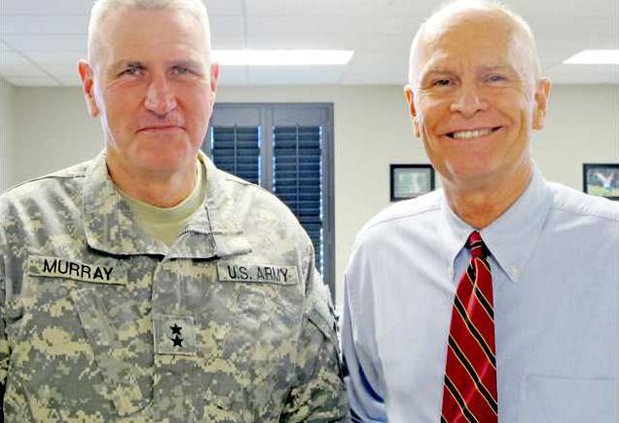Maj. Gen. Mike Murray, commander of the 3rd Infantry Division and Fort Stewart-Hunter Army Airfield, said he has a zero-tolerance policy for sexual assault among 3rd ID soldiers, whether on post or off. The Marne Division commander spoke candidly during an interview at the Coastal Courier on Wednesday afternoon.
As part of an area media tour, Murray came by the Courier’s office in downtown Hinesville to meet publisher Mark Griffin, managing editor Hollie Moore Barnidge and web editor Pat Watkins. Afterward, he took time to answer questions about changes taking place on Fort Stewart, including the inactivation of the division’s 2nd Brigade, training of soldiers and leaders, and his policy for preventing sexual assault.
He said there is a public misconception that sexual assaults are taking place in the barracks. Although some assaults take place in government housing, he said the majority of sexual-assault cases involving soldiers take place off post. Regardless where these crimes take place, however, Murray said he will not tolerate such behavior among his troops.
“When I came in here from day one, I said I was going to do everything I can to eliminate sexual assault at Fort Stewart and Hunter Army Airfield,” Murray said. “I’ve taken a very hard line with the soldiers I’ve had to deal with so far.”
Murray said he’s reminding soldiers and leaders of the importance of the buddy system. A soldier should never go anywhere alone, he said. He added that a new soldier should never be dropped off by the reception center at the barracks on a Friday, and every soldier coming to the installation will have a sponsor.
He said due to budget restraints, the timeline for the 2nd Armor Brigade Combat Team’s inactivation has moved up from 2017 to 2015. Nonetheless, he said it’s important for those soldiers and officers to continue to train. The Spartan Brigade currently is going through gunnery training.
Murray said the 4th Infantry Brigade Combat Team will take on North Atlantic Treaty Organization responsibilities shortly after it returns and is scheduled to go to the National Training Center at Fort Erwin, Calif., next fall. The 3rd ABCT at Fort Benning will take on U.S. Northern Command responsibilities when they return from Kuwait. Their mission will be to respond to emergencies in the homeland.
Murray admitted that many noncommissioned officers and officers have been unable to attend necessary leadership-development courses due to the Marne Division’s rotations to Iraq and Afghanistan. He said he expects the Army to waive some of the requirements for some soldiers, but efforts will be made to ensure 3rd ID leaders get the training they need for the sake of their careers and for the sake of the Army.
Murray said he couldn’t forecast the size of the force at Stewart-Hunter if the Army has to give up another 70,000 soldiers. He said, however, with the inactivation of the 2nd Brigade, the total troop strength at Stewart should be around 19,700 soldiers two years from now. That’s a loss of about 1,600 soldiers from its 2012 troop strength of 21,100. He added that if there is another troop reduction, the civilian workforce also will be affected.
“I’d be remiss if I didn’t mention our Vanguard (4th IBCT) Brigade that’s still downrange,” Murray said, concluding his remarks. “They’ll be coming home in the next 30-45 days. I’d ask everyone to keep them in their thoughts and prayers (until then).”
Commander getting to know area
General combatting sexual assault, suicide here


Sign up for our e-newsletters